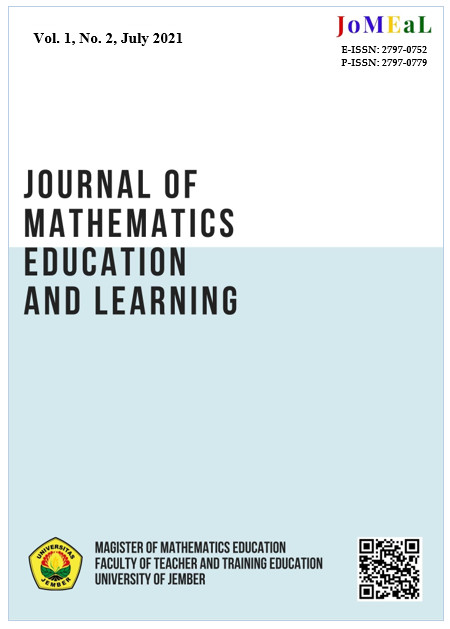Analisis Berpikir Siswa dalam Memecahkan Masalah Dimensi Tiga Berdasarkan Van Hiele
Abstract
In learning mathematics, innovation is still needed to make mathematics more easily understood by students, especially in the field of geometry. This becomes interesting when examined and is associated with van Hiele's level of geometrical thinking which is modified by Polya's problem solving steps. This study aims to determine the thought process of vocational students majoring in Modeling Design Engineering and Building Information in solving three dimensional problems. This type of research is a qualitative descriptive study. The research subjects are students of pre-visualization, visualization, analysis, and informal deduction level. The research subjects worked on the three dimensional problem test and were interviewed. The results obtained are pre-visualization level students fulfilling several indicators at the visualization level, students at the visualization and analysis level meet all indicators at their respective levels, while informal deduction level students are unable to meet one indicator when implementing a plan that is having another way of solving problems. This can be seen from the results of problem solving given and interviews conducted on research subjects.
Kata kunci: Berpikir, Pemecahan Masalah, Dimensi Tiga, Van Hiele
References
Budiman, H. (2015). Analisis Kemampuan Berpikir Geometri Mahasiswa Pendidikan Matematika. Jurnal Prisma, 4(8), 28–40.
Clements, D. H., & Battista, M. T. (1992). Geometry and Spatial Reasoning. New York: MacMilan.
Firmansyah, F. ., Sunardi, Yudianto, E., & Ambarwati, R. (2019). The Uniqueness of Viuals Levels in Resolving Geometry of Shape and Space Content based on Van Hieles’s Theory. Journal of Physics : Conference Series, 1211(1), 12076.
Fitriyani, H., Widodo, S. A., & Hendroanto, A. (2018). Students’ Geometric Thinking Based on Van Hiele’S Theory. Infinity Journal, 7(1), 55.
Haviger, J., & Vojkůvková, I. (2015). The van Hiele Levels at Czech Secondary Schools. Procedia - Social and Behavioral Sciences, 171, 912–918. https://doi.org/10.1016/j.sbspro.2015.01.209
Hepytriati. (2014). Profil Kemampuan Berpikir Kritis dan kreatif Siswa Kelas XI IPA SMAN Kota Bengkulu Tahun Ajaran 2013/2014. Universitas Bengkulu.
Hmelo-Silver, C. E., Liu, L., Gray, S., & Jordan, R. (2015). Using representational tools to learn about complex systems: A tale of two classrooms. Journal of Research in Science Teaching, 52(1), 6–35. https://doi.org/10.1002/tea.21187
Kemendikbud. (2018). Buku BSE Matematika Kelas XII. Jakarta: Kementerian Pendidikan dan Kebudayaan.
Kirkley, J. (2003). Principles for Teaching Problem Solving: Tachnical Paper #4. Indiana University: Plato Learning.
Marlina, L. (2013). Penerapan Langkah Ploya dalam Menyelesakan Soal Cerita dan Luas Persegi Panjang. Eektronik Pendidikan Matematika Tadulako, 1, 43–52.
Moleong, L. J. (2012). Metodologi Penelitian Kualitatif. Bandung: PT Remaja Rosdakarya.
Polya, G. (1973). How to Solve It. New Jersey: Princeton University Press.
Polya, G. (1973). How to Solve It: A New Aspect Mathematical Method. Princeton and Oxford: Princeton University Press.
Rawuh. (2009). Geometri Insidensi. Jakarta: Universitas Terbuka.
Reddy, Y. M., & Andrade, H. (2010). A review of rubric use in higher education. Assessment & Evaluation in Higher Education, 35(4), 435–448. https://doi.org/10.1080/02602930902862859
Sholihah, S. Z., & Afriansyah, E. A. (2017). Analisis Kesulitan Siswa dalam Proses Pemecahan Masalah Geometri Berdasarkan Tahapan Berpikir Van Hiele [Penelitian Studi Kasus di Kelas VII SMP Negeri 6 Garut]. Mosharafa, 6(2), 287–298.
Siswono, & Tatang, Y. E. (2008). Model Pembelajaran Matematika Berbasis Pengajuan dan Pemecahan Masalah untuk Meningkatkan Kemampuan Berfikir Kreatif. Surabaya: UNESA University Press.
Sugiyono. (2016). Metode Penelitian Pendidikan (Pendekatan Kuantitatif, Kualitatif, dan R&D). Bandung: Alfabeta.
Sukardi. (2011). Metodologi Penelitian Pendidikan (Kompetensi dan Praktiknya). Jakarta: Bumi Aksara.
Sunardi. (2000). Pengembangan Model Pembelajaran Geometri Berbasis Teori Van Hiele. Mathedu: Jurnal Pendidikan Matematika, 1(2), 71–82.
Sunardi, S., & Yudianto, E. (2015). Antisipasi Siswa Level Analisis Dalam Menyelesaikan Masalah Geometri. AdMathEdu : Jurnal Ilmiah Pendidikan Matematika, Ilmu Matematika Dan Matematika Terapan, 5(2), 203–216.
Thohari, K. (n.d.). Meningkatkan kualitas pembelajaran geometri dengan teori van Hiele (pp. 1–27). pp. 1–27.
Usikin, Z. (1982). Van Hiele Levels and Achievement in Secondary School Geometry. Chicago: The University of Chicago.
Utami, M. W., Setiawan, T. B., & Oktavianingtyas, E. (2016). Tingkat Berpikir Geometri Siswa Kelas VII-B SMP Negeri 1 Jember Materi Segiempat Berdasarkan Teori van Hiele ditinjau dari Hasil Belajar Matematika. Jurnal Edukasi, 3(2), 43–47.
Yudianto, E., Sunardi, Sugiarti, T., Susanto, Suharto, & Trapsilasiwi, D. (2018). The identification of van Hiele level students on the topic of space analytic geometry. Journal of Physics: Conference Series, 983(1), 1–5. https://doi.org/10.1088/1742-6596/983/1/012078














